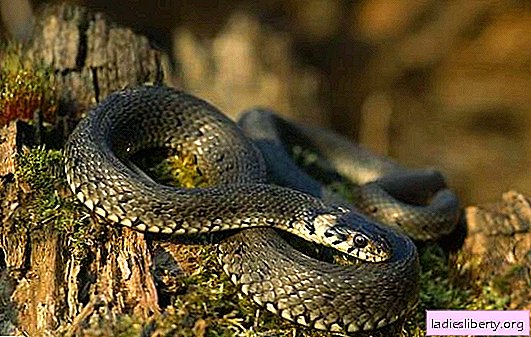
Vipers are one of the representatives of the family of poisonous snakes. You can meet them not only in exotic countries, but also in the forests and glades of our country. Let us consider in more detail what to do if the viper has bitten and how to help the victim.
What to do if you were bitten by a viper: signs of poison
Since the viper is a poisonous snake, accordingly, its bite will not remain without manifestations. Typically, the penetration of poison into the blood is accompanied by such characteristic symptoms:
1. Acute pain at the site of the bite.
2. Isolation of blood from the bite.
3. The development of severe edema in the affected area during the first two days.
4. The appearance of necrosis or large blisters on the wound.
5. The development of lymphadenitis (a condition in which a person's lymphatic bonds become highly inflamed).
6. Dizziness.
7. Nausea.
8. Migraine.
9. Heat in the body.
10. Redness of the wound.
11. Weakness.
12. The increase in heart rate.
13. Respiratory failure.
14. Inhibition of consciousness.
It is also important to say that poisons from different vipers can affect the human body in different ways. There are two main types of poisons:
1. Poisons paralytics. Once in the body, they cause paralysis of the respiratory system. In this case, in the absence of timely medical care, a person may die from sudden asphyxiation or swelling of the larynx.
2. Destructive poisons. When penetrating into blood cells, such poisons destroy their structure, which leads to a violation of blood coagulation and vasospasm. This condition is treated, but only with quick medical attention.
As for the bite area, most often the snake throws itself on a limb (leg or arm). On the bite zone, pain immediately arises, and two traces of fangs are visible.
What to do if a viper has bitten: first aid
After a snake bite, you need to act according to this scheme:
1. As soon as possible transfer the victim from the "danger zone" where he was bitten. Moreover, if the incident occurred in a forest or in a clearing, then this distance should be at least one hundred meters, since there is a high probability that there was not one snake there.
2. Lay the person in such a way that his head is below the level of the pelvis and his legs are raised. This will ensure normal blood circulation and reduce the risk of complications in the brain.
3. Next, you need to carefully examine the affected area. If the snake has bitten through the clothes, then it needs to be removed, since the fabric may contain more poison. In this case, the victim may be lucky (if the tissue was coarse and thick, then it is likely that he received less poison).
4. If drops of poison are near the wound, then they must be carefully wiped so that they can not get into the blood. It’s also worth keeping calm and not worrying yourself, as you certainly can’t help this victim.
In addition, it should be remembered that all actions should be as quick as possible, because the patient’s life largely depends on this.
5. If after a bite there was no one nearby, then the wound should be tightly wrapped in your own hands and pressed so that the poison can leak out. Doctors also advise making special cruciform incisions to allow blood to leak along with the poison, but this method is best practiced only with medical skills.
6. Next, you need to try to open the wound and actively suck out the poison with your mouth, massaging the affected part of the body. When performing this procedure, more than 40% of the poison can be removed from the wound within five minutes.
In this case, it is important to remember that the blood must be constantly spit so that it does not accidentally enter the body. You should also be prepared for the fact that the language is numb (due to the action of the poison). This symptom is not dangerous and over time it will pass.
Important! If there are wounds in the mouth or caries, it is strictly forbidden to suck out the poison.
After this procedure, rinse your mouth with alcohol.
7. If edema occurs, the wound must be treated with antiseptic solutions. In this case, it is better not to use greenback, as it will only make the further examination of the wound more difficult by doctors.
8. Fix the damaged limb. It is also better to generally lay the victim on a stretcher and immobilize, since any movements increase blood circulation, which leads to a greater spread of poison.
9. In advance, you need to remove bracelets, watches and rings from a bitten hand, since the limb will hurt and swell badly, and these items will only interfere.
10. Apply a sterile dressing to the wound. It is better if it is pre-saturated with hydrogen peroxide.
11. It is very important that after the bite of a viper the victim drank a lot of water. This fluid is needed to lower the concentration of poison. Also, the patient can be given diuretics.
12. If there is time before the arrival of doctors, then you need to monitor the general condition of the person. You can measure his pressure and body temperature. It is also important to control breathing and, at the first sign of asphyxia, do artificial respiration.
What to do if a viper has bitten: medical attention and consequences
The traditional treatment for snake bites is to be treated with antihistamines. The patient is prescribed taking Tavegil or Diphenhydramine tablets, however, with abundant penetration of the poison into the blood, such drugs will not help.
After arriving at the hospital, doctors must get ahead of the type of viper that bit the person. This will help them choose the right antidote (special serum).
Further treatment is based on the observed symptoms. Anti-inflammatory, antipyretic and analgesic drugs may be prescribed to the patient. Also, the victim can take medications to normalize heart rate and blood coagulation.
As for the consequences after this incident, in most cases a person survives and returns to his former life after a few weeks.
Fatal outcomes are observed in 5% of people, and then only with untimely medical care, when a person was self-medicating or did not pay attention to a snake bite at all.
It is also important to know that young children are particularly difficult to tolerate a viper bite, so they need to call a doctor as soon as possible.
What you can’t do if you are bitten by an adder
In order not to cause complications and not harm yourself even more, after a bite of a poisonous snake you need to know what you can not do:
1. You can’t try to cut a wound, as these actions can easily infect, damage muscles and cause severe bleeding. In severe cases, a person can even die from blood loss rather than from the action of poison.
2. Do not burn a wound with fire or objects that were previously red-hot on fire. The reason for this is that the snakes have rather long fangs, and it still does not work to burn out the poison. Instead, you can only burn your muscles.
3. Do not water the wound with various acids (potassium hydroxide, sulfuric acid, etc.), because this will lead to disastrous consequences.
4. The affected limb should not be too tightly wrapped, since edema will develop on it, and tightened tissue will impair blood circulation.
5. Do not apply a tourniquet above the affected area, as this can lead to gangrene and other complications in which a person dies tissue and develops blood stasis.
6. Do not cut the wound with painkillers or other medicines. In general, it is advisable not to inject any drugs to a person prior to the arrival of doctors.
7. Do not give the patient alcoholic beverages, since they are not an antidote, but rather contribute to the strengthening of the poison.
Viper bit: what to do to prevent this
Prevention of viper bites involves the following recommendations:
1. When you go outdoors, you must definitely wear high boots.
2. Before you arrange things for a picnic, you need to carefully inspect the area for the presence of snakes.
3. In the forest, you need to hold children by the hand and not allow them to roam independently on bushes and various thickets.
4. There is no need to panic at the sight of a snake. You should calmly move to a safe distance. Throwing anything into the snake is prohibited, as this will only provoke her aggression.
5. A snake can also be identified by a characteristic hiss. If you hear this, it is better to play it safe and leave the dangerous place.
6. If the snake rose and took an active pose, then you need to slowly step back. In this case, you can not put your hands in front of you and turn your back to it.
In addition, when meeting with the snake opposite, you don’t need to run away from it (and it makes no sense - if you want, it will catch up anyway). Instead, you should wait until the viper creeps by itself (usually snakes do not touch people, they only attack when there is a clear threat from the person).
7. At night, you need to use a lantern, because often in the summer snakes crawl closer to people.
8. Time to destroy rodents in private buildings, as they are attractive food for vipers.











